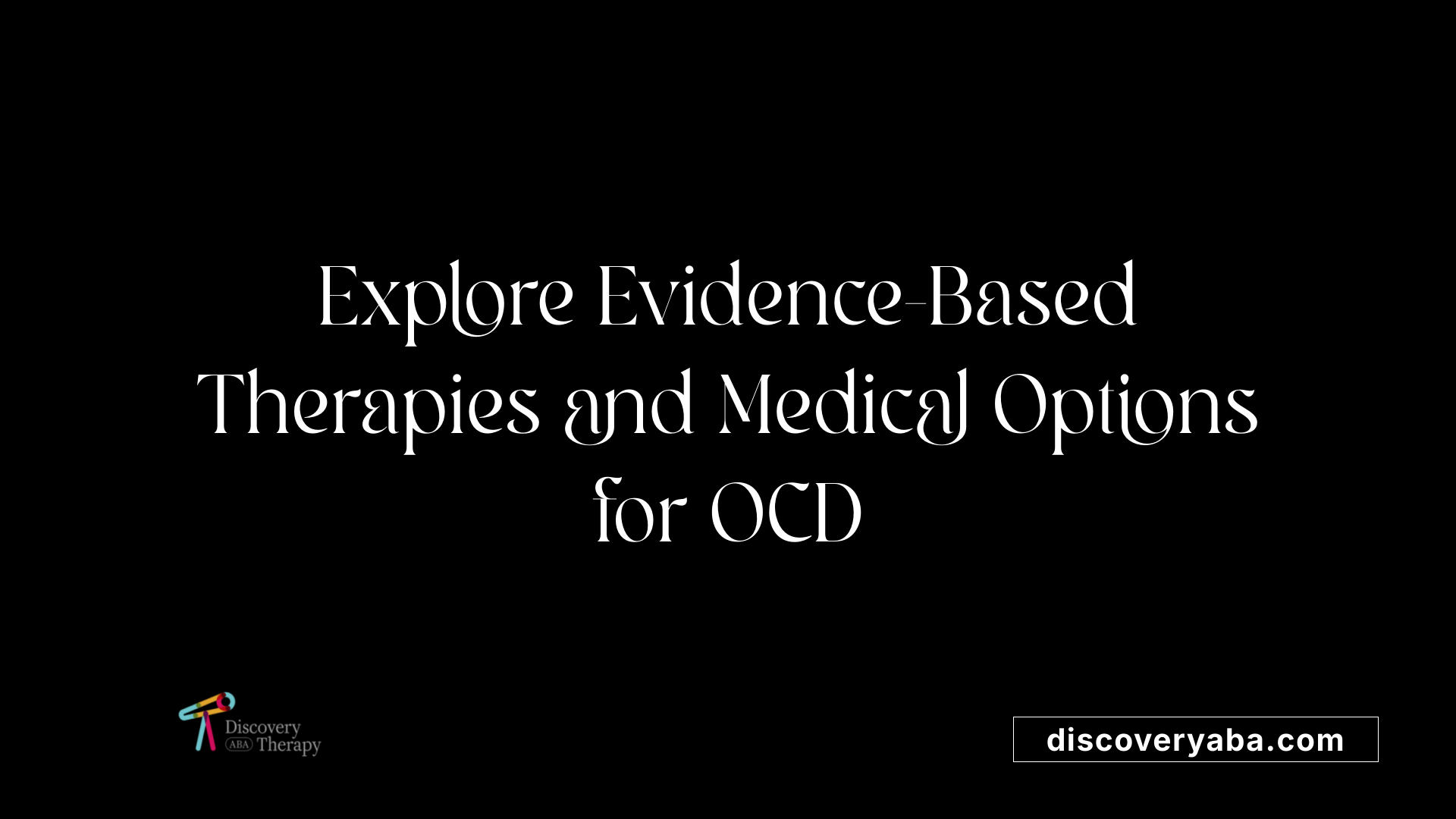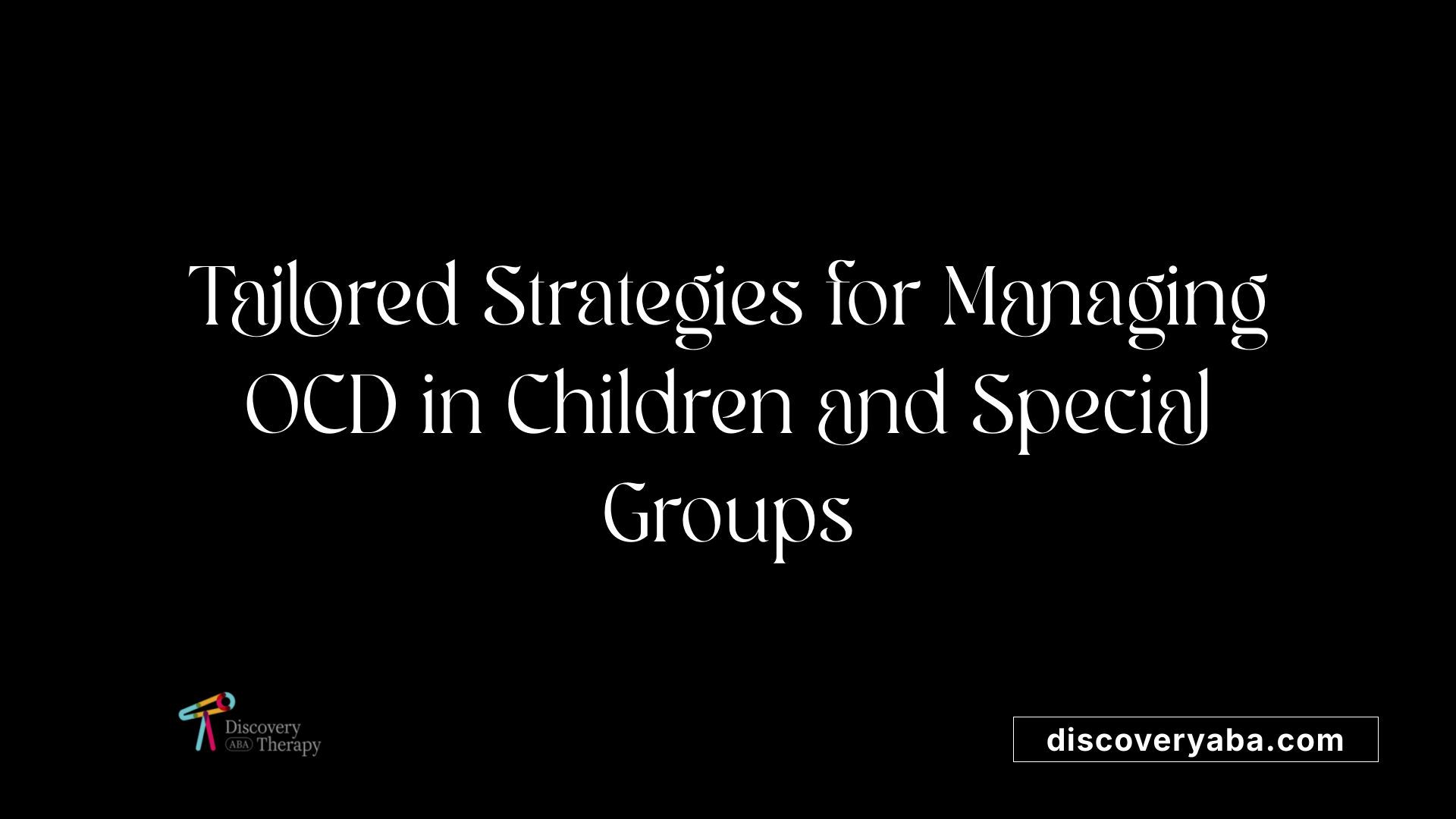Behavioral strategies for addressing compulsive behavior
Unlocking Effective Behavioral Techniques to Combat Compulsions

Understanding and Managing the Cycle of Compulsive Actions
Compulsive behaviors, characterized by persistent and often distressing actions or thoughts, can significantly impair daily functioning and quality of life. Recognizing the broad spectrum of these behaviors—from repetitive handwashing and checking to mental rituals—is essential for tailoring effective treatment. This article explores evidence-based behavioral strategies that help individuals identify triggers, resist compulsions, and develop healthier coping mechanisms, with insights into therapeutic approaches, family involvement, and specific strategies for different populations.
Effective Therapeutic Approaches for Managing Compulsive Behaviors

What are effective therapeutic approaches for managing compulsive behaviors?
Managing compulsive behaviors involves a combination of psychological therapies, medications, and sometimes advanced medical interventions. The most well-supported and first-line treatment is Cognitive Behavioral Therapy (CBT), particularly a technique called Exposure and Response Prevention (ERP). ERP gradually exposes individuals to their specific obsessions or triggers while instructing them to resist performing the compulsive behavior. Over time, this exposure helps reduce anxiety and break the cycle of compulsive action.
In addition to ERP, various supplementary techniques enhance treatment outcomes. Cognitive restructuring helps individuals challenge and reframe obsessive thoughts, decreasing their influence. Mindfulness practices such as meditation and deep breathing foster awareness, acceptance, and emotional regulation, which can diminish the intensity of intrusive thoughts.
Habit Reversal Training (HRT) is another behavioral approach, especially useful for body-focused repetitive behaviors like hair-pulling or skin-picking. HRT increases awareness of urges and introduces competing responses to control the urge.
Relaxation methods, including progressive muscle relaxation and guided imagery, are also effective in reducing stress, which often exacerbates compulsive tendencies.
When behavioral and psychological interventions are insufficient, medications like selective serotonin reuptake inhibitors (SSRIs) are prescribed. SSRIs help to balance brain chemicals affected in OCD and related disorders, often leading to noticeable improvement.
For individuals with severe or treatment-resistant symptoms, advanced treatments are available. Transcranial Magnetic Stimulation (TMS) uses targeted magnetic fields to influence brain activity, providing relief in some cases. Deep Brain Stimulation (DBS), an invasive procedure involving electrical impulses, and even surgical options, are considered experimental or last resort measures for severe cases.
Combining these approaches—therapy, medication, and advanced treatments—tailors a comprehensive, personalized strategy for effectively managing compulsive behaviors.
| Treatment Type | Examples | Purpose | Notes |
|---|---|---|---|
| Psychological | CBT with ERP, habit reversal training, mindfulness, relaxation techniques | Address behaviors, thoughts, emotional regulation | Evidence-based, first-line approaches |
| Medications | SSRIs, other antidepressants | Modulate brain chemistry, reduce compulsions | Often combined with CBT |
| Advanced Therapies | TMS, DBS, surgery | For severe, refractory cases | Under research and specialist care |
Understanding and applying these strategies can significantly improve daily functioning and quality of life for individuals struggling with compulsive behaviors.
Identifying Triggers and Developing Coping Mechanisms
How can individuals identify triggers and develop coping mechanisms for compulsive behaviors?
Recognizing the specific cues that precede compulsive behaviors is a vital step in managing them effectively. Individuals can start by paying close attention to the situations, thoughts, or feelings that occur just before engaging in a compulsive action. This might involve keeping a journal or mental note of circumstances that increase urges—for example, feelings of boredom, stress, or anxiety.
Once triggers are identified, the next step is to develop strategies that help cope with these urges without acting on them. Acceptance of intrusive thoughts is fundamental; rather than trying to suppress these thoughts, acknowledging their presence can lessen their power. Techniques like mindfulness help individuals become aware of their thoughts and feelings without judgment, creating a space for self-control.
Grounding objects, visualization, and distraction techniques are also effective. For example, a person might hold a textured object in their hand to anchor their attention or visualize a calming scene to shift focus away from distressing thoughts. Distraction can involve engaging in a different activity, such as walking or listening to music, to divert attention from compulsive urges.
Environmental modifications and routine creation serve as preventive measures. Changing the environment—such as removing accessible stimuli that trigger compulsions—reduces temptation. Establishing daily routines provides structure and stability, decreasing the likelihood of impulsive behaviors driven by environmental cues.
Connecting with peer support groups and utilizing evidence-based strategies like Cognitive Behavioral Therapy (CBT) and Exposure and Response Prevention (ERP) further enhance management. Support groups foster a sense of community and shared experience, which can alleviate feelings of loneliness. Professional therapies focus on systematically addressing the underlying thoughts and behaviors, equipping individuals with tailored tools for change.
Consistent practice of these techniques—alongside guidance from mental health professionals when necessary—empowers individuals to take control over their urges. Recognizing triggers early and responding with effective coping strategies can significantly reduce the frequency and intensity of compulsive behaviors, leading to improved well-being and quality of life.
The Role of Acceptance, Uncertainty, and Habituation in Treatment
Why is accepting uncertainty recommended?
Many individuals with obsessive-compulsive disorder (OCD) and related conditions find relief when they learn to accept that some degree of uncertainty is inevitable. This shift in mindset helps reduce the compulsion to seek absolute certainty, which often fuels compulsive rituals.
Understanding that nothing is entirely certain allows a person to tolerate doubt without needing to perform compulsions to eliminate it. For example, rather than repeatedly checking if the door is locked to quell worries, acceptance encourages acknowledging the possibility of uncertainty and allowing that doubt to exist without acting on it. This practice lessens the anxiety tied to not knowing, gradually diminishing the need for compulsive behaviors.
How does habituation help in managing intrusive thoughts?
Habituation is a process where repeated exposure to a feared stimulus or thought leads to decreased emotional response over time. By consistently facing intrusive thoughts without reacting with compulsive rituals, individuals can desensitize themselves to these distressing feelings.
In therapy, techniques like exposure and response prevention (ERP) utilize habituation by exposing patients to their fears gradually. As they resist acting on their compulsions, their anxiety diminishes naturally, enabling them to better tolerate similar thoughts or situations in real life. This sustained exposure diminishes the power of intrusive thoughts and reduces the frequency and intensity of compulsive responses.
How can identifying compulsions and signs of compulsive behaviors assist in management?
Recognizing symptoms of compulsiveness is a vital step in treatment. Common signs include a sense of urgency to perform rituals, feelings of relief after completing a compulsive act, and an increasing need to do more to achieve the same calming effect.
Examples include repetitive behaviors such as excessive cleaning, checking, hoarding, or mental rituals like repeated praying or counting. These behaviors often develop as a way to reduce distress or prevent feared outcomes.
Being aware of these signs enables individuals to implement coping strategies early. It also helps therapists tailor interventions, such as behavioral modification techniques or cognitive restructuring, more effectively addressing specific compulsions.
What techniques can help manage or reduce compulsive rituals and obsessive thoughts?
Effective management of compulsive rituals and obsessive thoughts involves a combination of strategies. Cognitive-behavioral therapies, particularly exposure and response prevention (ERP), play a central role. ERP involves systematically exposing individuals to feared stimuli while preventing the performance of compulsions, leading to habituation and a decreased urge to ritualize.
Mindfulness practices, such as meditation and deep breathing exercises, promote awareness of thoughts without judgment. These techniques help individuals observe intrusive thoughts without acting on them, breaking the cycle of compulsiveness.
Developing healthy routines and stress management strategies—like regular physical activity, adequate sleep, and proper nutrition—enhance resilience. Support networks, whether through family, friends, or support groups, provide emotional reinforcement.
Moreover, challenging all-or-nothing thinking and accepting thoughts as mere mental events, rather than realities, diminish their distressing impact. Avoiding reassurance-seeking behaviors also reduces dependence on compulsions for temporary relief.
What are the benefits of accepting uncertainty in reducing compulsive behaviors?
Embracing the notion that certainty is unattainable diminishes the compulsion to perform rituals to eliminate doubts. This acceptance fosters psychological flexibility, enabling individuals to tolerate the discomfort of ambiguity.
Research indicates that accepting uncertainty decreases the frequency and intensity of compulsive behaviors, as the need for reassurance and ritualization decreases. It also promotes mindfulness—remaining present and observing thoughts without judgment—which is crucial in breaking free from compulsive cycles.
Ultimately, accepting uncertainty not only reduces anxiety but also encourages a healthier, more adaptable approach to life's inevitable ambiguities, leading to sustained improvement and better quality of life.
Family Involvement and Support in Behavioral Treatment
How can family support be involved in the behavioral treatment of compulsive behaviors?
Family members can have a significant impact on the success of behavioral treatments for compulsive behaviors. Their active involvement can help reinforce progress outside of therapy sessions. Participating in family-based interventions such as psychoeducation, communication training, and problem-solving activities equips families with the tools needed to support their loved ones effectively.
A critical aspect of family support is reducing accommodation behaviors. These are actions by family members that unintentionally reinforce compulsions, such as assisting with rituals or providing reassurance. High levels of accommodation can make compulsive symptoms worse and hinder treatment progress. To address this, clinicians often use assessment tools like the Family Accommodation Scale for OCD (FAS) to measure and identify these behaviors, enabling targeted interventions.
Educating families about OCD and its treatment strategies is vital. When family members understand the nature of the disorder, including why certain behaviors are problematic and how therapies like exposure and response prevention (ERP) work, they can better support their loved ones without inadvertently enabling compulsions. This education fosters empathy and patience, creating a more supportive environment.
Involving families in treatment also facilitates better communication and reduces misunderstandings. Strong family support can alleviate stress and conflict, which are often triggers for compulsive behaviors. Family sessions can strengthen relationships and improve overall family dynamics.
Furthermore, families play a crucial role in relapse prevention. Teaching family members how to recognize early signs of relapse and encouraging them to reinforce therapeutic gains at home can sustain progress over time. Consistent support and encouragement from family members are essential for long-term recovery.
By actively participating in therapy and implementing strategies learned during treatment, families can help their loved ones manage compulsive behaviors more effectively, enhancing the overall success of the therapeutic process.
Behavioral Strategies Tailored for Children and Specific Populations

What strategies are effective for helping children with compulsive behaviors?
Helping children who exhibit compulsive behaviors involves a tailored approach that combines professional treatment, family support, and environmental adjustments.
One of the most effective methods is cognitive-behavioral therapy (CBT), especially exposure and response prevention (ERP). This therapy helps children face their fears and anxiety-provoking stimuli while resisting the urge to perform compulsions. Through structured exposure tasks, children learn to reduce their compulsive responses over time.
Parental involvement is crucial. Caregivers are trained in ERP techniques so they can support their child's progress at home. It’s important for parents to avoid accommodating OCD behaviors, such as giving reassurance or enabling rituals, because this can reinforce the disorder. Instead, setting firm limits and teaching children healthy ways to cope fosters independence.
Consistent management includes establishing routines and boundaries that help the child feel secure. Educating both the child and the family about OCD reduces confusion and enhances cooperation.
Medication such as selective serotonin reuptake inhibitors (SSRIs) might be recommended in some cases, especially when symptoms are severe. Support groups can also provide families with shared strategies and emotional backing.
How is functional assessment used in autism and OCD?
In children with autism spectrum disorder (ASD) or OCD, functional assessment plays a vital role in understanding the specific triggers and reinforcement patterns maintaining compulsive behaviors. This assessment identifies antecedents—events that trigger the behavior—and consequences that reinforce it.
In autism, some compulsive behaviors—like repetitive touching, ordering, or checking—are maintained through social reinforcement (such as attention) or sensory stimulation.
By analyzing these patterns, therapists design personalized interventions that target these maintained functions. For example, if a behavior is maintained by sensory input, providing appropriate sensory activities can reduce the need for repetitive actions.
What is closed hierarchy exposure for autism spectrum disorder?
Closed hierarchy exposure involves creating a structured, step-by-step plan that gradually exposes children to anxiety-provoking stimuli. For children with autism, this approach can mitigate compulsive behaviors by progressively increasing exposure difficulty within a controlled environment.
This method helps the child build tolerance and confidence, with clear steps and benchmarks. It often combines visual supports, social stories, or schedules to ensure clarity and predictability.
How to manage compulsive behaviors in adolescents with autism?
Managing compulsive behaviors in adolescents requires ongoing monitoring, environmental adjustments, and skill-building. Techniques include setting clear, consistent routines and substituting problematic routines with engaging, adaptive activities.
Swapping sugary foods for healthier, sugarless options and placing foods in opaque containers can help reduce compulsive eating. Diversion strategies, such as offering alternative activities after triggers, are also effective.
Creating daily routines that are safe and productive helps adolescents feel more in control. Behavioral strategies include changing routines or environments that trigger harmful behaviors.
Why is individualized intervention important?
Every child is unique, and their needs evolve over time. Tailoring interventions ensures that strategies address specific triggers and reinforce positive behaviors effectively.
Continuous assessment allows adjustments to be made as the child's symptoms change or if new challenges arise.
Ongoing support from healthcare teams, educators, and family members is essential to sustain progress and adapt to developmental changes.
| Strategy | Application | Notes |
|---|---|---|
| Behavioral Therapy | ERP, CBT | Customized to child's fears and routines |
| Family Involvement | Training in therapy techniques | Critical for generalization of skills |
| Routine and Environment Adjustments | Structured schedules, safe spaces | Reduce triggers and support independence |
| Pharmacotherapy | SSRIs, others | Considered when appropriate |
| Support Groups | Peer and family support | Share coping strategies |
Maintaining well-being involves stress management, healthy sleep habits, regular physical activity, mindfulness, and kindness to oneself. Collaborating with healthcare providers to incorporate these strategies helps manage symptoms effectively.
In summary, managing compulsive and intrusive behaviors in children and special populations demands a comprehensive, individualized approach that combines therapy, environmental adjustments, medication, and family involvement. With ongoing support and tailored strategies, children can learn to cope better and improve their quality of life.
Types and Examples of Compulsive Behaviors

What are common examples of compulsive behaviors?
Compulsive behaviors encompass a wide range of actions that individuals feel driven to perform repeatedly, often to alleviate anxiety or prevent negative outcomes. These behaviors can be physical, mental, or subconscious, and frequently interfere with daily life despite the awareness of their irrationality.
One of the most recognizable categories involves physical actions. Repetitive handwashing, cleaning, checking doors or appliances, and ordering objects are common. Such behaviors are typically linked to obsessions related to cleanliness, safety, or orderliness.
Mental compulsions involve internal rituals that help neutralize distressing thoughts. These include repeating phrases or prayers, mentally reviewing past events, or performing mental counting. For example, a person might silently recite specific words to prevent perceived negative consequences or reframe distressing thoughts.
Other behavioral examples feature hoarding, which involves collecting and resisting discarding items, often leading to clutter that impairs living spaces. Excessive re-arranging of objects and frequent reassurance seeking from others to confirm safety or correctness are also common.
Physical compulsions extend beyond handwashing and checking. Skin-picking, hair pulling (known as trichotillomania), and nail-biting are body-focused repetitive behaviors that serve as outlets for stress or anxiety.
Many individuals also engage in unconscious or subconscious rituals. These include behaviors that feel automatic, such as avoiding certain triggers without conscious awareness or engaging in mental or physical routines to relieve distress.
Despite recognizing their irrationality, those with compulsive behaviors often feel compelled to act, as doing so temporarily reduces anxiety or prevents feared consequences. Understanding these behaviors helps in developing targeted strategies for treatment and management.
Immediate and Natural Approaches to Suppress Intrusive Thoughts
How can one stop OCD intrusive thoughts naturally and immediately?
Managing intrusive thoughts associated with Obsessive-Compulsive Disorder (OCD) requires a combination of mental strategies and lifestyle practices that promote acceptance and resilience. Although instant suppression isn’t always feasible, adopting specific approaches can significantly reduce the distress linked to these thoughts.
A fundamental technique is mindfulness and acceptance. This involves observing intrusive thoughts without judgment or reaction, recognizing that they are just thoughts—not urgent signals requiring immediate action. Instead of fighting or suppressing these mental intrusions, accepting their presence helps weaken their hold.
Exposure and Response Prevention (ERP) plays a vital role in diminishing the power of intrusive thoughts over time. This strategy involves gradually facing feared stimuli or thoughts and resisting the compulsive or reassurance-seeking behaviors that often follow. Repeated exposure helps habituate the brain, making these thoughts less threatening and reducing the urge to act on them.
Another essential component is avoiding reassurance and compulsive responses. Engaging in such behaviors provides temporary relief but ultimately reinforces OCD patterns, making thoughts more persistent. Learning to observe thoughts passively—without attempting to suppress or act upon them—can lessen their intensity.
Self-care practices are also instrumental in supporting mental stability. Regular physical activity, nutritious diet, adequate sleep, and stress management techniques like meditation, deep breathing, or journaling can bolster overall resilience against OCD symptoms. These routines help create a healthier environment for the mind to process and cope with intrusive thoughts.
While immediate relief varies among individuals, consistent practice of acceptance, mindfulness, exposure, and self-care can lead to gradual, long-lasting reductions in intrusive thoughts. Engaging with a mental health professional can provide personalized guidance, especially when such thoughts are persistent or debilitating.
Overall, understanding that intrusive thoughts are common and manageable can empower individuals to confront them calmly. Through patience and structured strategies, the frequency and distress caused by these thoughts can decrease, leading to improved daily functioning and well-being.
Different Types of OCD and Their Manifestations

What are the different types of OCD?
Obsessive-Compulsive Disorder (OCD) is a complex condition that manifests in various forms. The main types are generally classified into checking, contamination, symmetry and ordering, and ruminations or intrusive thoughts. Each type has unique characteristics and coping challenges.
Checking OCD
This form involves a persistent urge to recheck certain objects, places, or actions. Common compulsions include repeatedly verifying if doors are locked, appliances are turned off, or that harm has not been caused. These behaviors are driven by fears of danger, such as causing harm to oneself or others, or potential accidents. The compulsive checking provides temporary relief from the anxiety but often leads to longer rituals.
Contamination OCD
Individuals with contamination OCD harbor an intense, often irrational fear of germs, dirt, or chemical exposure. This fear drives excessive cleaning, washing hands repeatedly, avoiding contaminated surfaces, or staying away from people or objects perceived as unclean. These behaviors aim to prevent illness or perceived harm but can severely restrict daily life and social interactions.
Symmetry and Ordering OCD
This type is characterized by a need for objects to be arranged in a precise, symmetrical way. People may spend hours organizing, lining up items, or performing rituals to achieve an internal sense of
A Path Forward: Combining Knowledge and Support for Lasting Change
Addressing compulsive behaviors requires a comprehensive understanding of effective behavioral strategies, effective therapeutic approaches, and the active involvement of individuals, families, and healthcare professionals. Success hinges on consistent practice, tailored interventions, and ongoing support systems. Strategies like ERP, cognitive restructuring, mindfulness, and environmental modifications empower individuals to break free from the cycle of compulsions. Family support and early intervention are critical components in fostering a sustainable recovery, especially for children and special populations. By adopting a multifaceted, empathetic approach rooted in evidence-based practices, individuals can achieve meaningful relief and reclaim control over their lives.
References
- Self-care for obsessive compulsive disorder (OCD) | Mind
- Tips & Advice: Managing Compulsive Behaviors | AFTD
- Compulsive Behaviors | Psychology Today
- Cognitive-Behavioral Therapy for Obsessive-Compulsive Disorder
- How to Stop Compulsive Behaviors: Managing OCD
- Management Strategies for Obsessive-Compulsive Disorder - AAFP
- OCD (Obsessive-Compulsive Disorder): Symptoms & Treatment
- Compulsive Behavior | Symptoms & Treatment Options | Zencare
- [PDF] Treatment of Socially Mediated Compulsive Behavior in a High ...
- Obsessive-Compulsive Disorder: When Unwanted Thoughts or ...
Does Your Child Have An Autism Diagnosis?
Learn More About How ABA Therapy Can Help
Find More Articles
Contact us
North Carolina, Nevada, Utah, Virginia
New Hampshire, Maine
Arizona, Colorado, Georgia, New Mexico, Oklahoma, Texas
.avif)


































































































